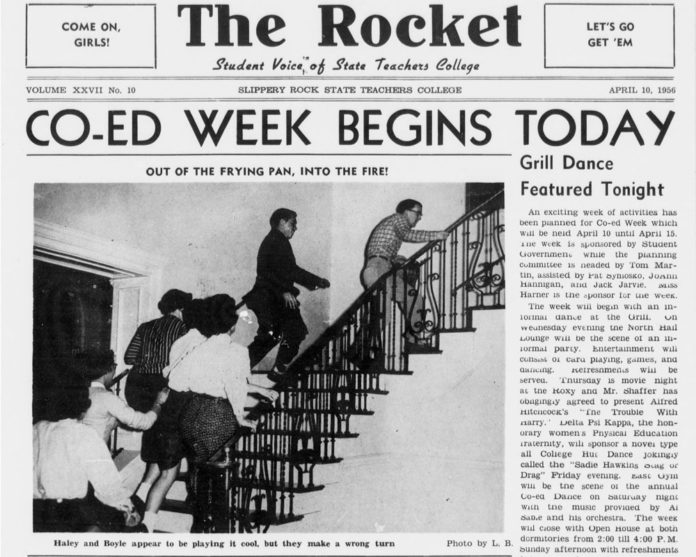The Rocket has been Slippery Rock University’s student newspaper since 1934, and since then a lot has changed on this campus. Back then Slippery Rock was a teacher’s college and the rules on campus regarding sex and love were a lot more strict. As one would expect for the time, men would be in the lead for pretty much any sort of romantic excursion. Male students would pick female students up at their dorms, help them with their coats, hold open doors, pull out chairs and foot whatever bill the night would produce. This was normal procedure back in the day, however there are a series of articles in The Rocket’s archived editions that reference a ‘co-ed’ week that would happen on campus once a year. Reading through the almost 80 year old articles one could find what might just be SRU’s forgotten tradition.
Co-ed week was held the week after Easter and it was a whole week when the gender roles in romance were flipped. The women on campus would ask out the men, plan the dates, help them with their coats, hold doors open for them and pay all the expenses.
The earliest mention of a co-ed dance appears in an edition of The Rocket from Feb. 23, 1938. It announces a second annual co-ed dance, held on Feb. 26, in which, “each girl invites a boy, arranges the dances, provides for refreshments, and may even gladden his button hole with a boutonniere…” The article continues, “and some of the more aggressive souls may call for their partner and escort him to the gym.”
The annual co-ed dances must have been very popular, as by 1941 the first mention of a full co-ed week can be found. An article in The Rocket from Feb. 12, 1941 lays out that girls will be escorting the boys around all week. This was seen as a way to show the opposite sex what having the shoe on the other foot was like. The article states, “Come on girls, show your spirit. You ‘gripe’ about the men and their attitudes, don’t turn down a perfect chance to show them what you can do…By all means keep those self-assured males guessing as to whom you are taking to the dance.”
Co-ed week keeps appearing annually in The Rocket for several years. In 1943 the event was put in jeopardy with a lack of men on campus due to the draft for World War II, but 500 Army Air cadets were stationed in Slippery Rock for training and the SRU women were still going to make the most of the week. “Maybe [the cadets] will be busy under a looie’s [lieutenant’s] thumb, but at least we can look at them marching past, and we won’t forget that a man under thirty-eight years of age looks like. (Apologies to the faculty),” the 1943 article reads.
By 1946 co-ed week was regarded as one of the most popular events on campus, with a student, Emaley Poast, putting tips for women on how to pick up boys in The Rocket on March 15. Some of the tips in the article include, “If any of you big-strong, handsome girls want to date any of those sweet young boys, you have to do the asking”, “if he’s a few minutes late, cut him short with one of those sarcastic remarks he uses on you when you’re not prompt”, “pick up his hankie when he drops it”, “when the lights are lowered [at a movie], tenderly hold his lily-white hand,” and “When you escort him back to South Hall at the end of a perfect night (I hope) kiss him goodnight. If he slaps you face (ouch), that’s just part of the game.”
Year after year The Rocket printed stories painting co-ed week as a success, each year more and more activities were added to the week’s planning such as spaghetti dinners, square dances, movie nights, hot dog roasts and the week was always capped off with the co-ed dance. The last mention of co-ed week appears in 1960 in the Feb. 19 edition of The Rocket. In 1961 co-ed week seems to just disappear and no mention of the once celebrated tradition can be found past that.
While it may have up and disappeared without a trace and was eventually forgotten, co-ed week one was of the highlighted tradition for Slippery Rock students on the 40s and 50s.








